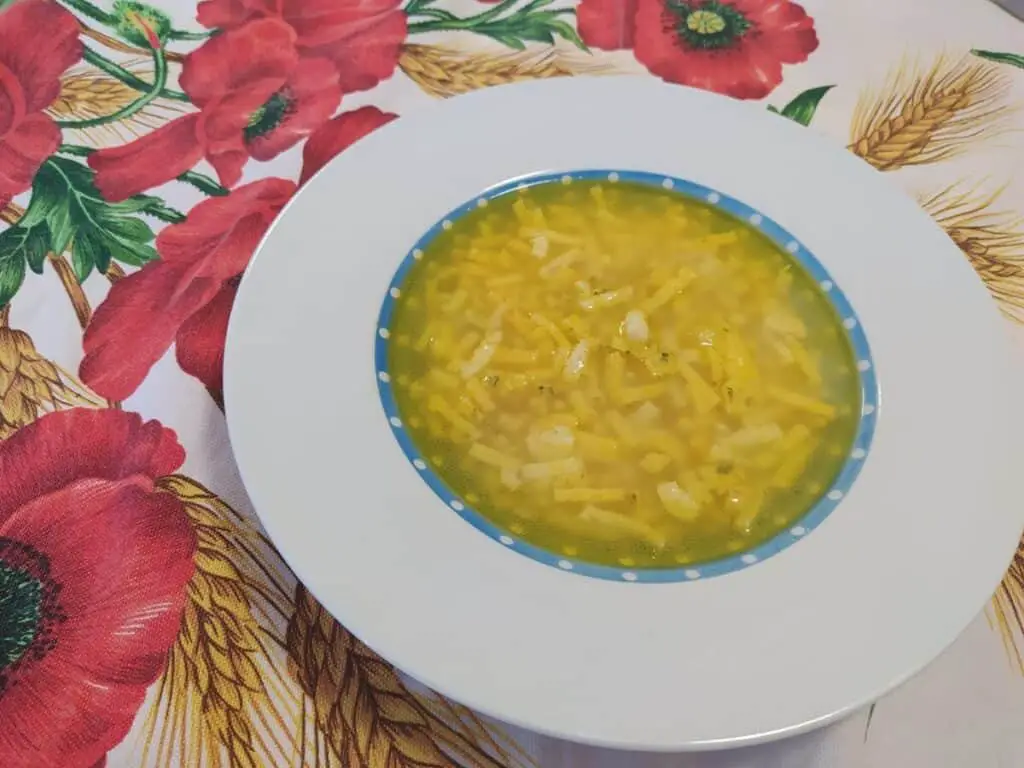If you have asked yourself why they don’t cut pizza in Italy, then this article is for you.
I will go through the reasons why traditional Italian pizza isn’t sliced before it’s served, whether Italians use a knife and fork to eat pizza, and differences between the traditional Italian pizza and pizza outside of Italy.
Keep reading to find out more
Table of contents:
- Why does traditional Italian pizza come unsliced?
- Do you eat pizza with a knife and fork in Italy?
- Types of pizza that you can find on most menus in Italy
- What pizzas do Italians prefer?
- How often is pizza eaten in Italy?
- What is the difference between pizza in Italy and abroad?
Why does traditional Italian pizza come unsliced?
Pizza at the restaurant in Italy is served unsliced in the great majority of cases, because this helps its presentation and flavour, preventing the runny pizza topping from leaking off the pizza base and wetting the edges. Not slicing the pizza for customers also minimizes the risk of it cooling down. It is certainly possible to ask the waiter to take your pizza back and slice it, although the great majority of Italians slice their own pizza.
Cutlery found at the table in an pizza restaurant in Italy almost always includes a sharp serrated knife so that customers can slice their pizza themselves.
The main reason why pizza comes unsliced at restaurants in Italy is that traditional pizza topping is quite runny, sometimes almost liquid, because the tomatoes and mozzarella used are very fresh.
When traditional Italian pizza is prepared, the tomatoes are not pre-cooked but squashed and spread on the pizza before it goes in the oven. They therefore produce a lot of liquid when the pizza heats. Good-quality mozzarella cheese is by nature very watery, and so also loses a lot of liquid when heated.
Here are details of how serving unsliced pizza helps its presentation and flavour:
- If a pizza it cut before it’s served, the topping will pour out of the base, ruining the appearance of the pizza and it will wet the edges, which are meant to stay dry, spoiling the character of the traditional Italian pizza.
- If pizza is cut before serving it, there is a risk that it will cool down in the journey from the kitchen to the table and the mozzarella cheese can become too chewy.
- Italian pizza is meant to be eaten very hot straight out of the oven, and it is therefore crucial that it is served as quickly as possible to prevent it cooling down before it reaches the customer.
As a general rule, Italians advise that traditional pizza is cut and eaten as you go, as pre-slicing it will ruin the flavour.
Another reason why traditional Italian pizza is not sliced is that, since, if well-made, it’s a highly digestible food, one whole pizza is meant for one person only, and there is therefore no assumption that the customer will need to share it.
Finally, Italians prefer cutting their own pizza because there is a number of ways in which pizza can be eaten, and this often comes down to personal preference (more on this below). If the pizza is unsliced, this allows the customer to slice it how they prefer.
There are some Italian restaurants which will slice pizzas for every customer before serving it, but pizza in Italy traditionally comes unsliced.
Nobody will be offended or annoyed if you are struggling to slice your pizza and wish to have it sliced for you, although the great majority of Italians cut it themselves.
It is mostly the elderly and children who have their pizza sliced by the waiters, or by helpful adults at the table.
Do you eat pizza with a knife and fork in Italy?
As a general rule eating your pizza with a fork and knife is preferred in Italy for two main reasons:
- The pizza and pizza topping are served very hot and must be eaten hot, so you would burn yourself if you picked it up with your hands
- Traditional pizza topping can be very runny, and pizza slices wouldn’t hold their shape if picked up, using a knife and fork therefore makes eating pizza less messy and more enjoyable.
There is a lot of variations among Italians in how they eat their pizza. Their choice depends on personal preference, the formality of the situation and how messy someone is willing to get.
As a general rule, Italians tend to use a knife and fork for the pizza core and hands for the edges which have very little topping and are dry.
Traditional pizza topping in Italy is almost liquid, and so the pizza won’t hold its shape when picked up. Some Italians who like to eat pizza with their hands get round this problem by folding each slice in two or four.
Eating Italian pizza with your hands can be messy, therefore your choice of eating it with your hands depends on how messy you are willing to make. In a formal situation, it might be preferable to use a knife and fork when eating your pizza.

Types of pizza that you can find on most menus in Italy
There are certain popular Italian pizzas that can be found on all pizza menus in Italy. These are:
- Margherita (tomato, mozzarella cheese, basil)
- Capricciosa (tomato, mozzarella cheese, mushrooms, olives, artichoke and ham)
- Diavola (tomato, mozzarella cheese, oregano, spicy salami)
- Marinara (tomato, garlic, oregano)
- Mari e monti (tomato, mozzarella cheese, seafood, mushrooms)
- Quattro formaggi (mozzarella cheese and other cheeses such as gorgonzola, provola cheese and fontina cheese)
- Vegetariana (tomato, mozzarella cheese and vegetables)
What Pizzas do Italians prefer?
A recent survey carried out in Italy to assess food preferences in the population showed that the majority of Italians prefer the round type of pizza that you eat in restaurants, called “pizza al piatto“.
Italians prefer traditional pizza with traditional toppings, with dough made using high-quality ingredients making it highly digestible, as opposed to fancy gourmet pizzas.
A more recent trend in Italy is preference for pizza that is made with sustainable ingredients and alternative flours such as wholegrain spelt, as opposed to conventional, industrially-produced flour.
Pizza preferences among Italians seem to be different between northern Italy, where ham and mushroom pizza is the top favourite, and southern Italy, where Margherita pizza with buffalo mozzarella is the top favourite.
How often is pizza eaten in Italy?
Most Italians eat pizza once per week, as discovered by the Italian survey mentioned above, but in young people aged between 18 and 24 pizza consumption was found to be much more frequent.
Pizza is considered to be a social food, but it’s also very affordable, so it’s likely to be the food of choice whenever young people spend time together.
What is the difference between pizza in Italy and abroad?
I have done some research on how Italians think that the traditional Italian pizza compares to pizza abroad, in particular to pizza in the US and UK.
Italians have a strong preference for traditional Italian pizza compared to US-style or UK-style pizza, because Italian pizza is lighter and more digestible, the ingredients are more genuine and it has fewer ingredients overall.
I have also found that the Domino pizza chain in Italy is disliked by most Italians. There seems to be a consensus that pizzas from restaurant chains have a less genuine flavour and lower-quality ingredients.
Here are some of the main differences between traditional Italian pizza and US-style or UK-style pizza:
- Pizza dough in Italy does not contain fats
Traditional Italian pizza is lighter and more digestible than US-style or UK-style pizza.
The traditional Italian pizza dough contains only flour, water yeast and salt. There are no additional fats in the dough.
- Italians don’t like pineapple or chicken as pizza toppings
Pineapple or chicken as pizza toppings are disliked by Italians mainly because they represent a step away from the tradition and Italians prefer tradition in many aspects of life, food included.
In addition to this, pineapple is sweet, and is therefore seen to clash with pizza as a savoury food.
That said, you do occasionally find Nutella pizza in Italian pizza menus. Nutella pizza is intended to add something a little more extravagant to a menu and is meant to appeal to children in particular.
- Traditional Italian pizza that you eat in restaurants in Italy is thinner than US-style and UK-style pizza
As a general rule, the traditional Italian pizza that you eat at the restaurant in Italy is much thinner than pizza made outside of Italy.
Neapolitan pizza does have thicker and crunchier outer edges, but the pizza core is quite thin.
Pizza in the US and UK more closely resembles “pizza al taglio” that you can get in Italy as a snack in pizza bars and sometimes bakeries.
- Traditional Italian pizza is less loaded with cheese and other toppings than US-style and UK-style pizza
Traditional Italian pizza is overall lighter and less caloric than US-style or UK-style pizza. Although certain types of traditional Italian pizza on the menu can have a number of different toppings, there tends to be less cheese on the pizza base, making the pizza lighter overall.
- Traditional Italian pizza does not contemplate stuffed crust
Stuffed crust is not contemplated in traditional Italian pizza. However, there are other types of pizza in Italy, for example “calzone”, which utilize the same ingredients as traditional pizza for the dough but are filled with various ingredients.
- Traditional Italian pizza is never accompanied by, or eaten with, sauces or dips
Dipping pizza in sauces or dips is a custom that is not traditional to Italy. Pizza in Italy is never served with sauces or dips..
- Pizza topping on traditional Italian pizza is almost liquid
Traditional Italian pizza has an almost liquid topping. This is because the tomato sauce is made out of fresh tomatoes, which produce a lot of liquid when oven cooked.
As I discussed above, this is one of the reason why they don’t tend to slice your pizza in Italy, but leave this to the customer instead.





